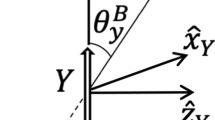Quantum mechanics can also be tested in high-energy physics; in particular, the neutral kaon system is very well suited. We show that these massive particles can be considered as qubits— kaonic qubits—in the very same way as spin–1/2 particles or polarized photons. But they also have other important properties, namely they are instable particles and they violate the C P symmetry (C... charge conjugation, P... parity). We consider a Bell inequality and, surprisingly, the premises of local realistic theories require strict C P conservation, in contradiction to experiment. Furthermore, we investigate Bohr’s complementary relation in order to describe the physics of the time evolution of kaons. Finally, we discuss quantum marking and eraser experiments with kaons, which prove in a new way the very concept of a quantum eraser.
Similar content being viewed by others
References
Bertlmann R.A, Entanglement, Bell Inequalities and Decoherence in particle physics. Lecture Notes in Physics (Springer-Verlag, Berlin, 2005), quant-ph/0410028.
Bertlmann R.A., Hiesmayr B.C, (2001). Phys. Rev. A 63, 062112
Gisin N, Go A. (2001). Am. J. Phys. 69, 264
Bertlmann R.A, Bramon A, Garbarino G, Hiesmayr B.C, (2004). Phys. Lett. A 332, 355
Nagata K, Laskowski W, Wieśniak M., Żukowski M., (2004). Phys. Rev. Lett. 93, 230403
Unnikrishnan C.S, (2005). Europhys. Lett. 69, 489
Uchiyama F, (1997). Phys. Lett. A 231, 295
Bertlmann R.A, Grimus W., Hiesmayr B.C, (2001). Phys. Lett. A 289, 21
Groom D.E. etal., (1998). Eur. Phys. J. C 3, 1
Feynman R.P, Leighton R.B, Sands M. The Feynman Lectures on Physics, Vol 3. Addison-Wesley, 1965), pp. 1–1, pp. 11–20.
Greenberger D, Yasin A. (1988). Phys. Lett A 128, 391
Englert B.-G., (1996). Phys. Rev. Lett 77: 2154
Bramon A, Garbarino G, Hiesmayr B.C, (2004). Phys. Rev A 69, 022112
Hiesmayr B.C,Vedral V. “Interferometric Wave-Particle Duality for Thermodynamical systems, quant-ph/0501015.
Arndt M, Nairz O, Vos-Andreae J., Keller C, Van der Zouw G., Zeilinger A. (1999). Nature 401, 680682
For example, a “red Ferrari racing through a double slit” (as demonstrated by Markus Arndt at the Symposium “Bose–Einstein condensation and quantum information” at the Erwin Schrödinger Institute, Vienna, December 2005).
Scully M.O., Drühl K., (1982). Phys. Rev. A. 25: 2208
Dürr S., Rempe G. (2000). Opt. Commun. 179, 323
Herzog T.J, Kwiat P.G, Weinfurter H, Zeilinger A. (1995). Phys Rev Lett 75: 3034
KimY. -H., Yu R, Kuklik S.P, Shih Y, Scully M.O, (2000). Phys Rev Lett. 84, 1
Tsegaye T, Björk G., Atatüre M., Sergienko A.V, Saleh B.W.A, Teich M.C, (2000). Phys. Rev A 62, 032106
Walborn S.P, Terra Cunha M.O., Padua S, Monken C.H, (2002). Phys. Rev. A 65, 033818
Trifonov A, Björk G., Söderholm J., Tsegaye T. (2002). Eur. Phys. J. D 18, 251
Kim H, Ko J, Kim T. (2003). Phys. Rev. A 67, 054102
Aharonov Y., Zubaiy M.S, (2005). Science 307, 875
Bramon A, Garbarino G, Hiesmayr B.C, (2004). Phys. Rev. Lett. 92, 020405
Bramon A, Garbarino G, Hiesmayr B.C, (2004). Phys. Rev. A 68, 062111
The authors of Ref. 18 used type–I crystals in their experiment.
Thanks to this normalization, we work with bipartite two–level quantum systems like polarization entangled photons or entangled spin–1/2 particles. For an accurate description of the time evolution of kaons and its implementation consult Ref. 2.
Apstolakis A. etal., (1998). Phys. Lett. B 422, 339
Author information
Authors and Affiliations
Corresponding author
Rights and permissions
About this article
Cite this article
Bertlmann, R.A., Hiesmayr, B.C. Kaonic Qubits. Quantum Inf Process 5, 421–440 (2006). https://doi.org/10.1007/s11128-006-0026-1
Received:
Accepted:
Published:
Issue Date:
DOI: https://doi.org/10.1007/s11128-006-0026-1




